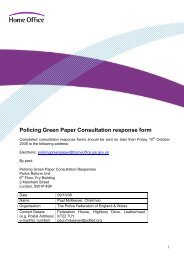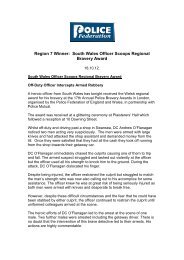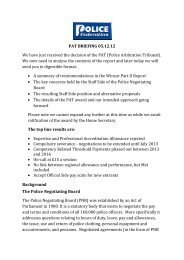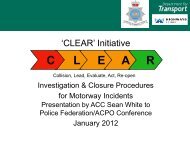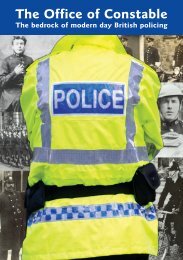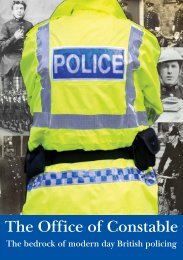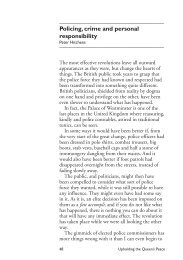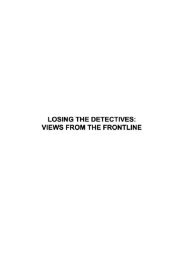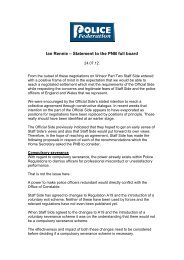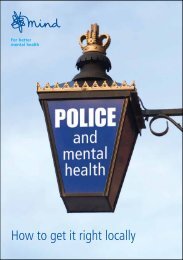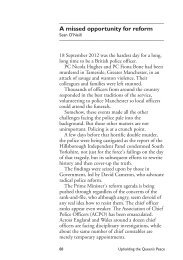Policing UK 2013 - Police Federation
Policing UK 2013 - Police Federation
Policing UK 2013 - Police Federation
You also want an ePaper? Increase the reach of your titles
YUMPU automatically turns print PDFs into web optimized ePapers that Google loves.
THE ROLE OF POLICE<br />
“In recent years, Ceasefire has been<br />
a key strategy used by the Boston<br />
<strong>Police</strong> to reduce fatal and non-fatal<br />
shootings by 31 per cent.”<br />
research ensures that the intervention is<br />
properly focused on the most violent gangs<br />
in Boston and the conflicts and alliances<br />
of these gangs are well understood.<br />
The strategy itself is co-ordinated by an<br />
interagency working group of criminal<br />
justice, social service and communitybased<br />
partners. Analysis helps to inform<br />
their decision-making.<br />
The Operation Ceasefire focused<br />
deterrence strategy is designed to prevent<br />
violence by reaching out directly to<br />
gangs, saying explicitly that violence<br />
would no longer be tolerated, and<br />
backing up that message by ‘pulling every<br />
lever’ legally available when violence<br />
occurred.<br />
A co-ordinated response<br />
The chronic involvement of gang<br />
members in a wide variety of offences<br />
makes them, and the gangs they form,<br />
vulnerable to a co-ordinated criminal<br />
justice response.<br />
The criminal justice agencies<br />
disrupt street drug activity, focus police<br />
attention on low-level street crimes<br />
such as trespassing and public drinking,<br />
serve outstanding warrants, cultivate<br />
confidential informants for mediumand<br />
long-term investigations of gang<br />
activities, deliver strict probation and<br />
parole enforcement, seize drug proceeds<br />
and other assets, ensure stiffer plea<br />
bargains and sterner prosecutorial<br />
attention, request stronger bail terms<br />
(and enforce them), and bring potentially<br />
severe federal investigative and<br />
prosecutorial attention to gang-related<br />
drug and gun activity.<br />
Simultaneously, youth workers,<br />
probation and parole officers, and<br />
clergy and other community groups<br />
offer gang members services and other<br />
kinds of help. Providing gang youth<br />
with opportunities and services is an<br />
important element of the strategy.<br />
Community and social service partners<br />
also deliver an explicit message<br />
that violence is unacceptable to the<br />
community and that ‘street’ justifications<br />
for violence are mistaken.<br />
The interagency working group<br />
delivers this message in formal meetings<br />
with gang members (known as ‘forums’<br />
or ‘call-ins’), through individual police<br />
and probation contacts with gang<br />
members, through meetings with inmates<br />
at secure juvenile facilities in the city, and<br />
through gang outreach workers.<br />
The deterrence message is not a deal<br />
with gang members to stop violence.<br />
Rather, it is a promise to gang members<br />
that violent behaviour will evoke an<br />
immediate and intense response. If<br />
gangs commit other crimes but refrain<br />
from violence, the normal workings of<br />
police, prosecutors, and the rest of the<br />
criminal justice system deal with these<br />
matters.<br />
However, if gang members shoot<br />
people, the Ceasefire working group<br />
concentrates its enforcement actions on<br />
their gangs. An ongoing working group<br />
process monitors the city for outbreaks<br />
of gang violence and frames any<br />
necessary responses in accord with the<br />
Ceasefire strategy.<br />
Key strategy<br />
Operation Ceasefire was associated with<br />
a two-thirds reduction in youth homicides<br />
during the 1990s. In recent years,<br />
Ceasefire has been a key strategy used by<br />
the Boston <strong>Police</strong> to reduce fatal and nonfatal<br />
shootings by 31 per cent – from 377<br />
shooting victims in 2006 to 259 shooting<br />
victims in 2011. Equally important,<br />
the Ceasefire strategy is embraced by<br />
the community as a legitimate gang<br />
violence prevention strategy. We believe<br />
this legitimacy is accrued for, at least,<br />
three reasons.<br />
First, community members, especially<br />
black clergy, are involved in the strategy.<br />
Law enforcement actions are transparent<br />
to these influential community members.<br />
Second, gang members are warned<br />
to halt their violent behaviour before<br />
criminal justice agencies deliver a strong<br />
law enforcement response.<br />
Third, gang youth who want the<br />
opportunity to change their life<br />
trajectories are provided with services to<br />
help that happen.<br />
Increasing trust<br />
In closing, it is appropriate to point out<br />
that the lessons of Ceasefire fit well within<br />
the wise teachings of Sir Robert Peel who<br />
famously stated that “the police are the<br />
public and the public are the police.”<br />
In the opening words of a police<br />
handbook issued to all members of the<br />
precursor to the London Metropolitan<br />
<strong>Police</strong>, Peel said: “When many offenders<br />
are committed, it must appear to the<br />
Commissioners that the police is not<br />
properly conducted in the Division; and<br />
the absence of crime will be considered<br />
the best proof of the complete efficiency<br />
of the police.”<br />
Indeed, Ceasefire is focused on<br />
producing the outcome of reduced<br />
shootings through the strategic use<br />
of a smaller number of arrests and<br />
prosecutions. Leaving neighbourhoods<br />
intact and ultimately increasing<br />
community trust in their police.<br />
POLICING <strong>UK</strong> | 67



